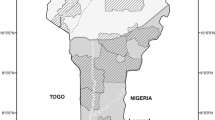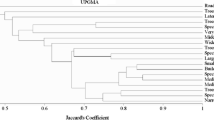Abstract
Forest-covered home gardens around the tropical world vary in their structure, but serve to supply food and other products for direct family consumption or marketing. Little quantitative data exist defining home garden structure. Thus, this study was undertaken to examine the variation in home garden structures in response to market or household needs and the subsequent variation in light interception and productivity.
Four home gardens were studied in the Department of the Petén, in northern Guatemala. Areal extent and height of canopies were mapped in transects through four gardens representing a range of site water regimes and market orientation. Light intensities incident on the ground were measured along each transect to assess light use. Results showed structural complexity, with full canopy closure in the one or more layers within the canopy for most gardens. The garden architectures made efficient use of light and space, with intersive management for food and fuel production. Farmers grew the crops for both cash and family subsistence. One home garden on a comparatively dry site with shallow soil seemed less structured, with only a single broken canopy layer, but with diverse species of plants.
The results indicate that development of gardens in this area utilized existing trees, thinning them to leave the most useful, and inserting other desirable trees and shrubs in the understory and in open spaces. This strategy seemed to maximize light use, regardless of market orientation.
This look at the structure and composition of four home gardens, in a forested area of current immigration, demonstrated (1) variety of organization and plant components, (2) different architecture for different soil/site conditions and market orientations, and (3) efficient use of available light through the arrangement of plants.
Similar content being viewed by others
References
Alcorn JB (1987) Indigenous agroforestry systems in the Latin American tropics. In: Altieri MA and Hecht SB, eds, Agroecology and Small Farm Development, pp 203–218, CRC Press, Boca Raton, FL
Asahira T and Yazawa S (1981) Report of the scientific survey on traditional cropping systems in tropical Asia. In: Tadayo Watabe, ed, Part I, India and Sri Lanka. Center for Southeast Asian Studies, Kyoto University, Japan
Asare EO, Oppong SK and Twum-Ampofo K (1990) Home gardens in the humid tropics in Ghana. In: Landauer K and Brazil M eds, Tropical Home Gardens, pp 138–146 United Nations University Press, Tokyo, Japan
Barrera A (1980) Sobre la unidad de habitación tradicional campesina y el manejo de recursos bióticos en el área Maya Yucatanense. I. Arboles y arbustos de las huertas familiares. Biótica 5: 115
Bojorquez D, Cabrera R, Chavez W, Enriquez L, Lopez H and Sagastume R (1988) Diagnostico del Recurso Forestal del Departmento del Petén. Guatemala: INAFOR
Brownrigg L (1985) Home Gardening in International Development: What the Literature Shows, League for International Food Education, Washington, DC
Decagon Devices Inc. (1989) Sunfleck Ceptometer User's Manual, Decagon, Pullman, WA
Gillespie AR (1989) Modelling nutrient flux and interspecies root competition in agroforestry interplantings. Agroforestry Systems 8: 257–265
Gómez-Pompa A and Kaus A (1990) Traditional management of tropical forests. In: Anderson AB, ed, Alternatives to Deforestation: Steps Toward Sustainable Use of the Amazon Rain Forest, pp 45–64, Columbia University Press, New York, NY
Karyono (1990) Home gardens in Java: their structure and function. In: Landauer K and Brazil M, eds, Tropical Home Gardens pp 138–146, United Nations University Press, Tokyo, Japan
Marcus J (1982) The plant world of the sixteenth-and seventeenth-century lowland Maya. In: Flannery KV, ed, Maya Subsistence, pp 239–273, Academic Press, New York, NY
Michon G and Mary F (1990) Transforming traditional home gardens and related systems in West Java (Bogor) and West Sumatra (Maninjau). In: Landauer K and Brazil M, eds, Tropical Home Gardens, pp 169–185. United Nations University Press, Tokyo, Japan
Morley SG, Brainerd GW and Sharer RJ (1983) The Ancient Maya, 4th ed, Stanford University Press, Stanford, CA
Nińez VK (1984) Household gardens: theoretical considerations on an old survival strategy. International Potato Center, Potatoes in Food Systems Research Series Report No 1 Lima, Peru
Puleston DE (1973) Ancient Maya settlement patterns and environment at Tikal, Guatemala: Implications for subsistence models. PhD dissertation, Department of Anthropology, University of Pennsylvania, Philadelphia, PA. University Microfilms International, Ann Arbor, MI
Puleston DE (1982) The role of ramón in Maya subsistence. In: Flannery KV, ed, Maya Subsistence, pp 353–366. Academic Press, New York, NY
Author information
Authors and Affiliations
Rights and permissions
About this article
Cite this article
Gillespie, A.R., Knudson, D.M. & Geilfus, F. The structure of four home gardens in the Petén, Guatemala. Agroforest Syst 24, 157–170 (1993). https://doi.org/10.1007/BF00706889
Issue Date:
DOI: https://doi.org/10.1007/BF00706889




